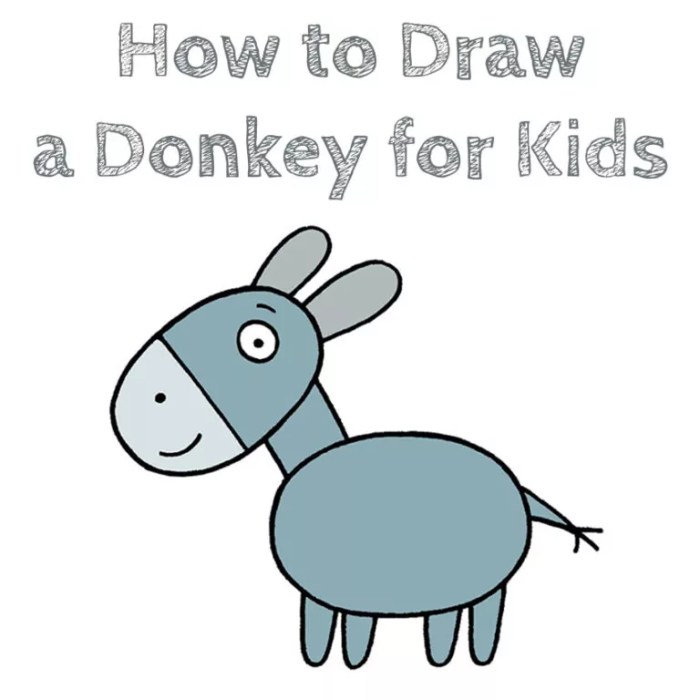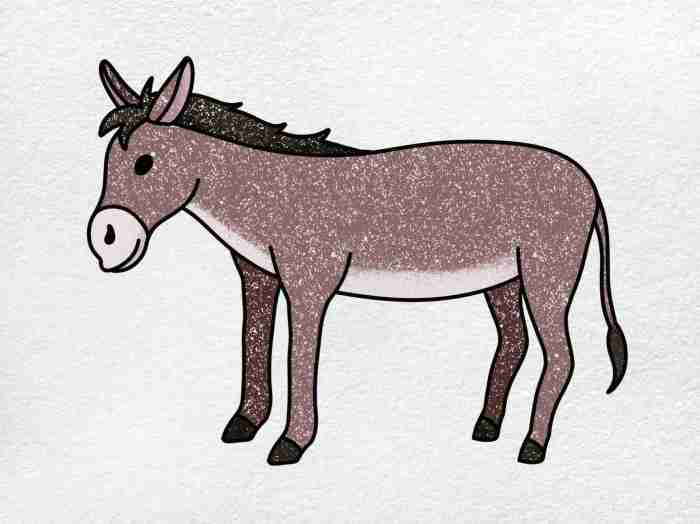Basic Donkey Anatomy for Drawing

Easy drawing of a donkey kicking – Drawing a donkey kicking requires understanding its underlying anatomy. While we’re focusing on the action, a solid grasp of basic proportions will make your drawing more believable and dynamic. We’ll break down the key aspects to help you capture the power and movement of the kick.
Donkeys, like horses, have a fairly straightforward body structure. However, their build is often stockier and more compact than a horse’s. Understanding this difference is crucial for accurately depicting their powerful hindquarters.
Donkey Body Proportions
The donkey’s body can be simplified into basic shapes for sketching. The head is roughly triangular, connecting to a relatively long neck. The body is deep-chested and slopes down to a powerful hindquarters. The legs are long and strong, especially the hind legs, which are vital for the kicking motion. The length of the donkey’s head is roughly equal to the length of its neck.
The body length, from withers to tail, is approximately twice the length of its head. The legs, from the hip joint to the hoof, are approximately the same length as the body. This is a general guideline; individual donkeys will show slight variations.
Step-by-Step Donkey Sketching, Easy drawing of a donkey kicking
- Start with a simple oval for the body: This oval should be slightly longer than it is wide, reflecting the donkey’s shape. Place it slightly off-center to leave room for the head and neck.
- Add the head and neck: Attach a smaller oval or triangle to the larger oval for the head. The neck should be a smoothly curved line connecting the head and body.
- Sketch the legs: Draw four long, slightly curved lines for the legs, starting from the body’s bottom. The hind legs should be positioned further apart to show stability for the kicking motion. The front legs are generally straighter than the hind legs.
- Define the hindquarters: Shape the hindquarters with a gentle curve, showing the musculature needed for a powerful kick. Notice how the muscles bulge slightly at the hip and thigh. The rump is broad and rounded.
- Add details: Refine the sketch, adding details like the ears, tail, mane, and hooves. Consider the angle of the donkey’s body to show the tension and power of the kick.
Key Muscle Groups in a Donkey Kick
The power behind a donkey’s kick comes from several major muscle groups. Understanding their placement helps you accurately depict the tension and movement in the drawing.
The most important muscle groups involved are the gluteals (buttocks), quadriceps (thighs), and hamstring muscles (back of the thighs). The gluteals are particularly crucial for the initial power of the kick. They initiate the movement, extending the hip joint forcefully. The quadriceps then work to straighten the leg, extending the knee, and delivering the impact. The hamstrings, while less prominent in the actual kick, are important for the controlled retraction of the leg after the kick.
These muscles work in a coordinated sequence to generate the power of the kick.
Depicting the Kicking Motion
Capturing a donkey’s kick in a drawing requires understanding the animal’s anatomy and the mechanics of the movement. We’ll explore three distinct kicking poses, focusing on the dynamic interplay of muscle tension and weight shift that makes the action believable. Remember, a successful drawing isn’t just about lines; it’s about conveying movement and energy.Understanding the dynamics of a donkey kick is key to creating a convincing illustration.
The kick isn’t a simple leg extension; it involves a complex interplay of the donkey’s entire body. Weight shifts dramatically, muscles tense and relax in a coordinated sequence, and the donkey’s posture changes significantly throughout the action. Observing real-life videos or photographs of donkeys kicking is invaluable for capturing these nuances.
Three Donkey Kicking Poses
Here are three variations of a donkey kick, showcasing different levels of leg extension and body posture. Imagine these poses as snapshots in a continuous motion.
Mastering an easy drawing of a donkey kicking involves capturing its dynamic energy. For a similar level of simplicity, consider the charming ease of drawing other animals, like the drawing of a tree frog easy , which helps build fundamental skills. Returning to our donkey, remember to exaggerate the leg movement for a more impactful, yet still simple, final sketch.
- Pose 1: The Gathering. The donkey is crouched slightly, hind legs flexed, weight slightly shifted back. The muscles of the hindquarters are visibly tensed, ready for the powerful exertion. The head is lowered slightly, adding to the sense of preparation. This pose highlights the initial phase before the kick.
- Pose 2: Mid-Kick. One hind leg is powerfully extended, the hoof reaching its maximum height. The donkey’s body is slightly arched, counterbalancing the force of the kick. The opposite hind leg is still planted, providing stability. The muscles of the extended leg are taut, while the other muscles show a degree of strain.
- Pose 3: The Follow-Through. The kicking leg is almost fully extended, its momentum carrying it past the peak. The donkey’s body is now recovering, weight shifting back to a more balanced position. The muscles are beginning to relax, though a slight tension remains. The head might be slightly raised, completing the action.
Phases of a Donkey’s Kick: A Sequence of Sketches
To better illustrate the kicking motion, consider a sequence of sketches, like frames in an animation.
- Stance: The donkey stands with its weight evenly distributed. Its muscles are relaxed, but its posture is alert.
- The Load: The donkey begins to shift its weight back, flexing its hind legs. Muscles in the hindquarters become visibly taut.
- The Launch: The donkey’s hind leg powerfully extends backward, propelling its body forward slightly.
- Peak Extension: The leg reaches its maximum extension, the hoof at its highest point. The body is in a dynamic counter-balance.
- The Recovery: The kicking leg begins to lower, weight shifting back to a balanced position. The muscles relax, but the donkey remains poised.
Imagine each of these phases depicted in a quick sketch. Start with simple stick figures to get the movement down, then add details like muscle definition and fur as you refine the drawings. This sequential approach allows you to capture the fluid motion of the kick effectively.
Adding Details and Expression

Now that you’ve got the basic donkey shape and kicking motion down, it’s time to bring your drawing to life! Adding details and expression will transform your sketch from a simple representation into a dynamic and engaging piece of art. We’ll focus on texture, facial expression, and movement.Adding texture to the donkey’s fur is crucial for realism. Different areas of the donkey will have varying textures, influencing your brushstrokes.
Fur Texture Techniques
To create a believable coat, consider varying your brushstrokes. For short, smooth areas like the donkey’s face, use short, light strokes, almost like stippling. For longer, coarser areas like the mane and tail, employ longer, more expressive strokes. You can even experiment with different tools – a softer pencil for smoother areas, a harder one for rougher textures. Think about using cross-hatching for deeper shadows and creating a sense of depth in the fur.
Experiment with blending techniques to soften transitions between areas of different textures. Imagine the way light catches the fur – some parts will be lighter, others darker, reflecting the direction of the light source.
Depicting Donkey Emotions
A donkey’s expression is primarily conveyed through its eyes and ears. For anger or frustration, you can draw the ears pinned back tightly against its head, and the eyes narrowed or squinted. The mouth might be slightly open, showing teeth. For a playful donkey, the ears would be more relaxed, perhaps slightly forward, and the eyes wide and bright.
The mouth might be slightly open in a soft smile or relaxed. The position of the tail can also add to the expression. A tense tail might indicate anger, while a swishing tail suggests playfulness. Consider subtle changes in the facial muscles to further enhance the expression. A slight furrow in the brow can add to the feeling of anger or concentration.
Creating Movement and Energy
To capture the energy of the kick, focus on dynamic line work and shading. Use flowing lines to depict the donkey’s musculature, emphasizing the tension in its legs and body. The lines should follow the direction of the movement, creating a sense of fluidity. Shading is key to conveying depth and movement. Use darker values to indicate areas where the muscles are most tense and where shadows are cast.
Highlight the areas where light hits the donkey’s body to create a sense of volume and form. Think about the motion blur you might see in a photograph of a kicking donkey – you can suggest this effect through blurred or slightly smudged lines in the areas of most rapid movement, like the kicking leg. Remember to consider the background; a simple, slightly blurred background will draw attention to the donkey’s dynamic pose.
Expert Answers: Easy Drawing Of A Donkey Kicking
What kind of pencils should I use?
HB for sketching, 2B or 4B for shading and details. Experiment to find your faves!
How do I make the kick look dynamic?
Focus on the lines of motion, exaggerating the leg extension and using dynamic poses. Think about the weight shift in the donkey’s body.
What if my donkey looks… stiff?
Loosen up those lines! Practice sketching quickly, focusing on movement rather than perfect accuracy at first. Don’t be afraid to erase and redraw!
Can I use digital art tools?
Absolutely! Procreate, Photoshop, Krita – the choice is yours. Adapt the techniques to your preferred software.
